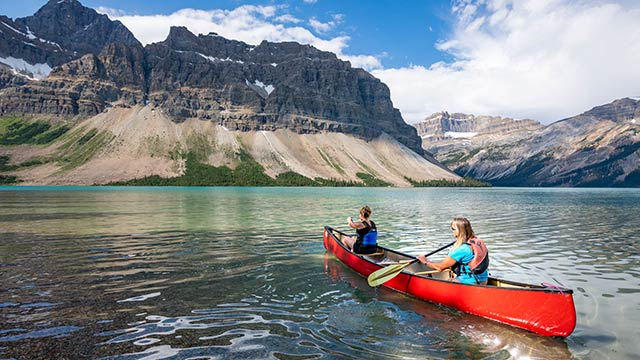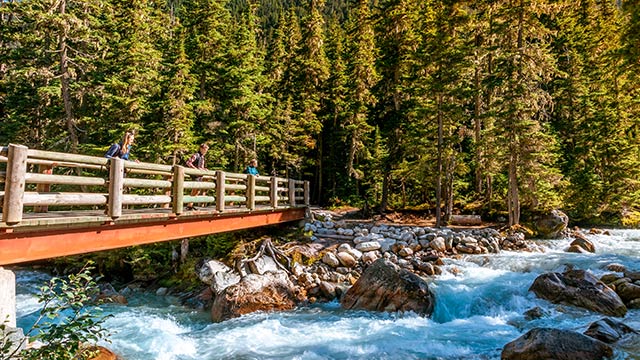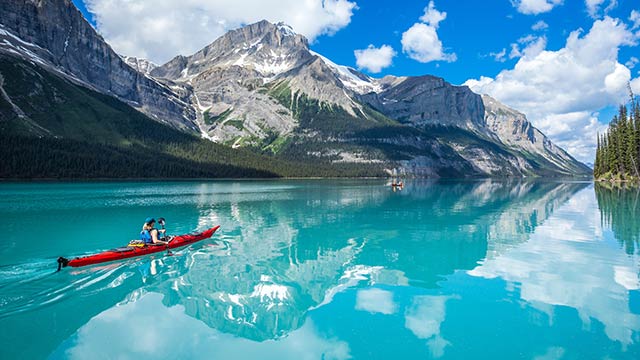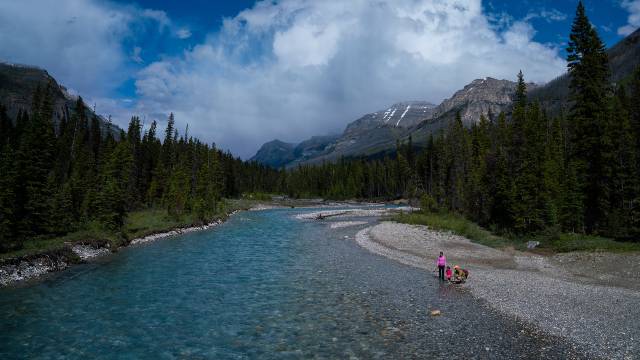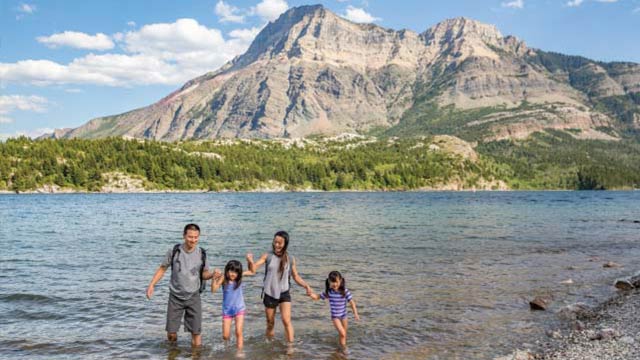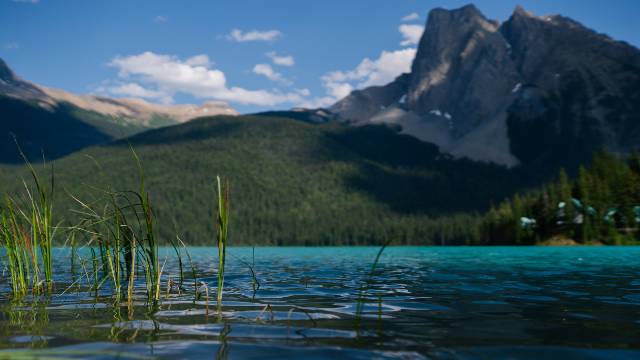
Protect park waters: preventing aquatic invasive species
Aquatic Invasive Species (AIS) are non-native plants, animals, and diseases. Many AIS are harmful to freshwater ecosystems. AIS reproduce quickly, rarely have natural predators and often out-compete native freshwater species.
Waterton Lakes National Park
Beginning April 1, 2024: all non-motorized watercraft from outside of the park are prohibited from entering waterbodies.
Yoho and Kootenay national parks
Until March 31, 2025: All waterbodies are closed to watercraft and angling to reduce the spread of aquatic invasive species, including whirling disease. Please visit the Water activity rules and regulations for more information.
Clean, drain, dry, and certify all watercraft and water-related gear before entering a new waterbody

Clean
all mud, sand, plant, and animal materials from your watercraft, gear, and angling equipment.
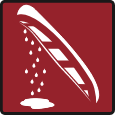
Drain
all watercraft, gear, and angling equipment before leaving the waterbody.

Dry
for at least 48 hours when last used within AB, BC, NWT, or YT; and at least 30 days when last used outside of AB, BC, NWT, or YT.

Certify
watercraft, gear, and angling equipment by visiting a Parks Canada inspection station or obtaining a self-certification permit.
How to: Clean, Drain, and Dry | Parks Canada
Transcript
[This video has no spoken language. Text appears on screen throughout the video.]
[Sounds of water and calm guitar music throughout the video.]
[Two people paddling a canoe; Parks Canada beaver logo appears.]
Text: Exploring Parks Canada’s lakes, streams and rivers is a popular way to see the national parks.
[Aerial view of large blue lake.]
Text: Yet these water bodies are vulnerable to aquatic invasive species.
[Two people paddling a canoe, paddleboarder behind them, on a lake.]
Text: These invaders can hitch a ride on watercraft like kayaks, inflatables and SUPs.
[Canoers and paddleboarder arrive to shore.]
[Images shown of zebra mussels and shelled invasive species.]
Text: Aquatic invasive species, once established, irreversibly damage ecosystems and harm species at risk.
[Canoers and paddleboarder arrive on shore.]
[The words “CLEAN DRAIN DRY” are written in mud on the back of a canoe. Water is slowly poured overtop and washes it away.]
[Canoers pull canoe onto shore.]
Text: Clean, Drain, Dry your watercraft and gear BEFORE and AFTER entering the water.
Large title on screen: Step 1: Clean
[Two people clean a canoe. A jug scoops water from a lake.]
[View from inside a canoe; water is poured onto the side of a canoe while a cloth wipes it down.]
Text: Clean all debris from your watercraft and water-related gear BEFORE and AFTER your trip.
[A paddleboard is wiped down with water and a cloth.]
[Two people pour water and wipe down the backside of a paddleboard.]
Large title on screen: Step 2: Drain
[Two people tip a canoe onto its side; water is emptied from a canoe on its side.]
Text: Drain coolers, buckets, compartments and other items that may hold water on land before leaving the waterbody.
[A paddle is pulled apart and emptied of water.]
Text: Some aquatic invasive species can survive in pools of water for 30 days.
[Two people stand a paddleboard up against a tree.]
Large title on screen: Step 3: Dry
[Two people wipe down the backside of a paddleboard. A close-up shows a hand wiping down a paddleboard with a cloth.]
Text: Use a clean towel to wipe down the entire watercraft. Set aside to dry.
[Two people wipe down a paddleboard with cloths.]
Text: Ensure items are completely dry before entering a new lake, stream or river.
[A close up of a paddleboard with water on it.]
[Two people walking through a forest, one person holding a paddleboard and another with PFD.]
[A person rolls a deflated paddleboard and wipes it down with a cloth as they roll it.]
[Two people pack a paddleboard into a bag.]
[A lake with two people paddling a canoe, and two people standing on paddleboards.]
Text: Sustainable aquatic ecosystems are vital to the overall health of Canada’s lakes, streams and rivers.
Text: Do your part to protect park waters: Clean, Drain, Dry.
[Logo] Parks Canada, Parcs Canada.
[Logo] Canada
How to certify
In most of the mountain national parks, an Aquatic Invasive Species (AIS) Prevention Permit is required to access waterbodies with any watercraft, gear, or angling equipment. The type of AIS Prevention Permit required is dependent on the park and the type of watercraft or gear. See below for current mandatory permit requirements.
Mandatory AIS prevention permitting requirements in the mountain national parks for 2024:| Motorized Watercraft | Non-motorized Watercraft | Angling equipment and other gear | |
|---|---|---|---|
| Banff |  Inspection Permit Inspection Permit |
 Self-Certification or Self-Certification or Inspection Permit Inspection Permit |
 Self-Certification Permit Self-Certification Permit Inspection Permit Inspection Permit |
| Jasper |  Voluntary inspection Voluntary inspectionInformation |
 Voluntary inspection Voluntary inspection |
 Voluntary inspection Voluntary inspection |
| Kootenay |  Prohibited Prohibited |
 Prohibited Prohibited |
 Prohibited Prohibited |
| Waterton Lakes |  90 Day Quarantine 90 Day Quarantine |
 Not applicable Not applicable |
 Self-Certification Permit Self-Certification Permit
|
| Yoho |  Prohibited Prohibited |
 Prohibited Prohibited |
 Prohibited Prohibited |
| Motor Boat | No Motor | Water Gear | |
|---|---|---|---|
| Banff |  Inspection Permit Inspection Permit |
 Self-Certification Permit or Self-Certification Permit or
 Inspection Permit Inspection Permit |
 Self-Certification Permit or Self-Certification Permit or
 Inspection Permit Inspection Permit |
| Jasper |  Voluntary inspection Voluntary inspectionInformation |
 Voluntary inspection Voluntary inspection |
 Voluntary inspection Voluntary inspection |
| Kootenay |  Prohibited Prohibited |
 Prohibited Prohibited |
 Prohibited Prohibited |
| Waterton Lakes |  90 Day Quarantine 90 Day Quarantine |
 Not applicable Not applicable |
 Self-Certification Permit Self-Certification Permit
|
| Yoho |  Prohibited Prohibited |
 Prohibited Prohibited |
 Prohibited Prohibited |
 Self-Certification Permit
Self-Certification Permit Self-Certification Permit (voluntary)
Self-Certification Permit (voluntary) Inspection Permit
Inspection Permit Roving inspection
Roving inspection 90 Day Quarantine
90 Day Quarantine Prohibited
ProhibitedWhere to certify
The Self-Certification permit and watercraft inspection stations are available at the following locations:
Banff National Park
Watercraft Inspection Stations:
- Lake Louise Inspection Station: Located in the Lake Louise overflow parking lot approximately 7 km southeast from the town of Lake Louise on Highway 1
- Lake Minnewanka Inspection Station: Located along the Minnewanka Loop Road, approximately 6 km northeast from the town of Banff
Self-Certification Permits are available at the following locations:
- Kiosks located at waterbody access points and trailheads
- Visitor centers
- Campgrounds
- Online
Jasper National Park
Kootenay National Park
Water activity restrictions in effect: All waterbodies in Yoho and Kootenay national parks are closed to watercraft and angling until March 31, 2025 to reduce the spread of aquatic invasive species (AIS), including whirling disease. Please visit the Water activity rules and regulations for more information.
Waterton Lakes National Park
Angling for all fish species will no longer be permitted at any time in flowing waters (streams and rivers) within the park. Angling will continue as per current regulations in still water (lakes).
Self-Certification Permit Locations:
| Belly River |
| Belly River Campground |
| Cameron Bay |
| Cameron Lake |
| Driftwood Beach |
| Emerald Bay North |
| Emerald Bay South |
| Hay Barn |
| Knight Lake |
| Linnet Docks |
| Marina |
| Maskinonge |
| Park gate |
| Townsite Campground kiosk |
| Visitor centre |
Yoho National Park
Water activity restrictions in effect: All waterbodies in Yoho and Kootenay national parks are closed to watercraft and angling until March 31, 2025 to reduce the spread of aquatic invasive species (AIS), including whirling disease. Please visit the Water activity rules and regulations for more information.
Aquatic Invasive Species of concern
Aquatic invasive species (AIS) are non-native plants, animals, and diseases. Many AIS are harmful to freshwater ecosystems. AIS reproduce quickly, rarely have natural predators and often out-compete native freshwater species. Preventing aquatic invasive species from entering waterways is a Parks Canada priority. Once AIS are established, removal is next to impossible.
-
Whirling Disease
Whirling disease is caused by a parasite that affects trout, whitefish, and salmon. The parasite develops in a fish’s skull and spine, resulting in skeletal deformities, difficulty swimming, and a dark or blackened tail. The parasite can be spread in mud and water on watercraft and waders. This disease is not harmful to humans or other mammals but can have significant effects on trout, whitefish, and salmon populations. -
Invasive mussels
Quagga and zebra mussels are small, fan-shaped species, that range from dark brown to white in colour. They are very efficient at filtering nutrients from the water, limiting food for native species. Dense colonies of mussels can clog water pipes, damage boats and infrastructure, and make shorelines and beaches unusable. Quagga and zebra mussels are often transported unknowingly to new waterbodies on boats and recreational equipment. New recent invasions have occurred in Manitoba and Idaho. -
Eurasian water milfoil
Eurasian water milfoil is a perennial, submersed aquatic plant native to Eurasia and North Africa. Eurasian water milfoil forms thick stands that shade native plants, decrease oxygen levels as they decay, and impede boating and swimming. New colonies can form from a single stem, seed, or leaf that can easily be spread attached to a watercraft, waders, or other gear.
Report aquatic invasive species sightings:
Email ReportAIS-SignalerEAE@pc.gc.ca with a description of the organism, photos, and a precise location (GPS coordinates preferred).
Sightings outside of the national parks can be reported to:
1-855-336-2628 (BOAT) in Alberta and 1-888-933-3722 in British Columbia.
- Date modified :
